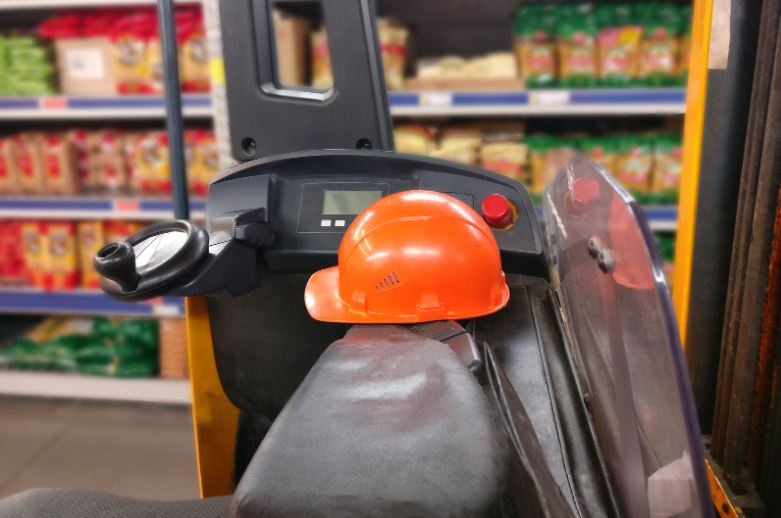Jake starts his day around 9 p.m. He cleans up and puts on khaki pants, a light-blue button-up shirt, and heavy-duty, steel-toed work shoes. Then he walks about a mile to his job at a local grocery chain store.
On the way, he thinks about the day ahead, already looking forward to the end of his shift. It’s a Sunday, which means he has two days off coming up. This is his “Friday,” so to speak.
As he arrives, it’s time to get back into the work mindset. There are supplies to unload and stock, and customers to help. He clocks in, and heads to his department.
Shop our custom collections
Jake works primarily in the fresh and frozen food sections, stocking goods like pizzas, box dinners, milk, and hamburger. He moves around pallets of goods, restocks on the floor, and loads overflow into a back-storage room.
He bought his sturdy shoes for a reason. “Once you get your foot run over by a pallet jack, you find steel-toed shoes,” he says.
On this day, like most others, Jake feels tired and sore about halfway through his shift. He’s 34 and not quite as energetic as he used to be, he explains. He pops a couple of Tylenol on his break. He typically tries to mitigate pain with aspirin, Tylenol, or cushioned foot insoles, he says.
Unlike other jobs, Jake isn’t allowed many distractions. Music might interfere with customer service, or offend others, he explains. If a co-worker is nearby that helps, since chatting passes the time more quickly. Otherwise, shifts can become monotonous.

Jake says his favorite part of the job is when he’s assigned to run the standup forklift in the back. “Then I get a break from stocking,” he says.
Jake typically takes his lunch about four hours into his day. He purchases something from his own frozen food section, and heats it up in the breakroom. “I shoot the bull with some co-workers if they’re on the same lunch,” he says.
On this particular day, a friend is heading back out as he comes into the breakroom. He eats his lunch and relaxes for a bit. The muscles that have been busy all morning start to throb. He feels pain the most in his arms, back, and feet.
Jake isn’t alone when it comes to dealing with chronic pain on the job. More than 200 others work at his store, and most of those he knows are sore by the end of a shift.

Industrial Athletes at Work
Around 2.7 million workers are employed in grocery store jobs in the U.S. alone, according to the Bureau of Labor Statistics. Thousands of those struggle with pain and workplace ergonomic issues. That’s likely because long-term floor employees like Jake are also vulnerable to injuries on the job. Many of these problems are musculoskeletal in nature, including back injuries, strains, and carpal tunnel syndrome.
Grocery store workers and those in other physical labor jobs are sometimes referred to as industrial athletes. That’s because the mental and physical stamina required to continue such work is similar to what a traditional athlete experiences.
In one recent medical report in the journal Occupation and Environmental Medicine, an expert recommended that industrial athletes be treated more like their sport counterparts.
“It is time for a conceptual shift in the treatment of these debilitating, and often frustrating injuries. Many similarities can be drawn between the athletic and industrial population … These injuries are often the same types of injuries that occur in workers because of the repetitive nature of their jobs; however, the treatment approaches by the medical community can be markedly different.”
-Thomas Sevier, Medical Director
Workplace Safety
Like with athletes, it’s particularly important for grocery store workers to focus on physical care and injury prevention. The Occupational Safety and Health Administration (OSHA) recommends specific physical techniques to lessen injury. Such tips include (among others):- Use a power-grip, even for lighter items. This involves wrapping your entire hand around a product, rather than just using fingertips.
- Two-handed lift for heavier items. For moderately heavy items, like a jug of milk, OSHA recommends using both hands. Even if one will do the trick, two will do less harm.
- Practice lift safety. This involves well-known methods like using leg muscles, but also moving smoothly and turning the whole body, rather than just the waist.

Learning Self-Care
Physical pain isn’t the only toll that heavy-duty jobs can take. Jake and others are facing typical stressors of a physical job, along with added requirements and dangers due to the pandemic. Physical and mental health go hand in hand. Stress can exacerbate pain and make one more prone to accidents. The CDC recommends workers make a point of self care. Here are five tips that can be helpful for industrial athletes, along with other workers:
-
Keep a regular sleep schedule. This can be tricker for those with non 8 to 5 jobs, but should still be a priority.
-
Practice mindfulness techniques. These are readily available online or in supportive apps. This can also be as simple as taking a walk in a nearby park and noticing the colors and sounds around you.
-
Talk to others about stress, particularly those who have similar challenges. Ask for mental health resources and support through work if needed.
-
Make a point to keep doing fun hobbies and activities outside of work, even if you have to find things you can only do from home.
- Notice negative thought patterns. Acknowledge and accept your feelings, while also remembering positive experiences and things you are thankful about.
Jake says he tries to focus on physical and mental self-care, but sometimes it’s enough just to get through the day. At the end of the shift, he’s not always sure if he can make it home.
But like on every other day, he powers through in the morning. He says he’s glad to have a couple days off, and looks forward to the chance to put his feet up.



